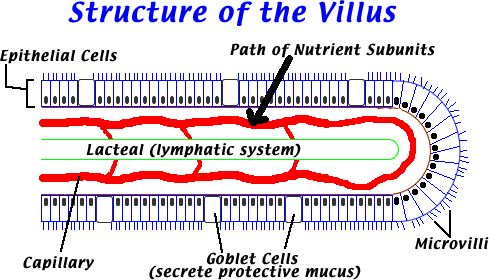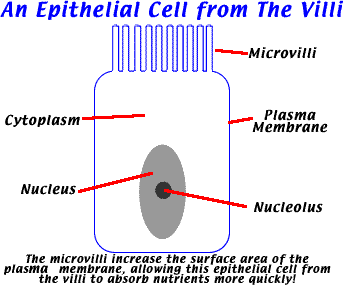
The villi are small finger-like projections of the wall of the small intestine which extend into the lumen or interior space of the small intestine. As digestion is completed in the small intestine, the villi are then bathed in a fluid which contains the nutrient subunits the cells need. These subunits include monosaccharides, amino acids, nucleic acids, glycerol and fatty acids. To get to the circulatory system which will then transport these subunits to the tissues of the body, the nutrient subunits must first pass through the wall of the small intestine to then enter capillaries which are embedded within the villi. This movement of nutrients into the blood is known as absorption.
Villus: singular form
Villi: plural form

 Important
Structural Characteristics of the Villus which Aid its Function:
Important
Structural Characteristics of the Villus which Aid its Function:
*The villi increase the surface area of the small intestine over which food may be absorbed.
*The villi are further covered by even smaller finger-like projections of the plasma membranes of the epithelial cells lining the vili which are known as microvilli. These microvilli further increase the surface area for absorption on the wall of the small intestine.
*The plasma membranes of the microvilli contain numerous protein channels which allow rapid and efficient passage of nutrient subunits via facillitated diffusion.
*The plasma membranes of the microvilli also contain numerous pumps which use ATP to actively transport molecules across the membrane.
*To assist active transport, the cytoplasms of the epithelial cells lining the villi contain numerous mitochondria which provide a source of ATP for the pumps.
*A dense network of capillaries lines the insides of the villi. Thus the nutrient subunits need only pass a short distance from the lumen of the small intestine before they are taken up by the blood.
*A lacteal is a duct at the center of the villus which conducts fats away from the villus after they have been absorbed.Lacteals are part of the lymphatic system.